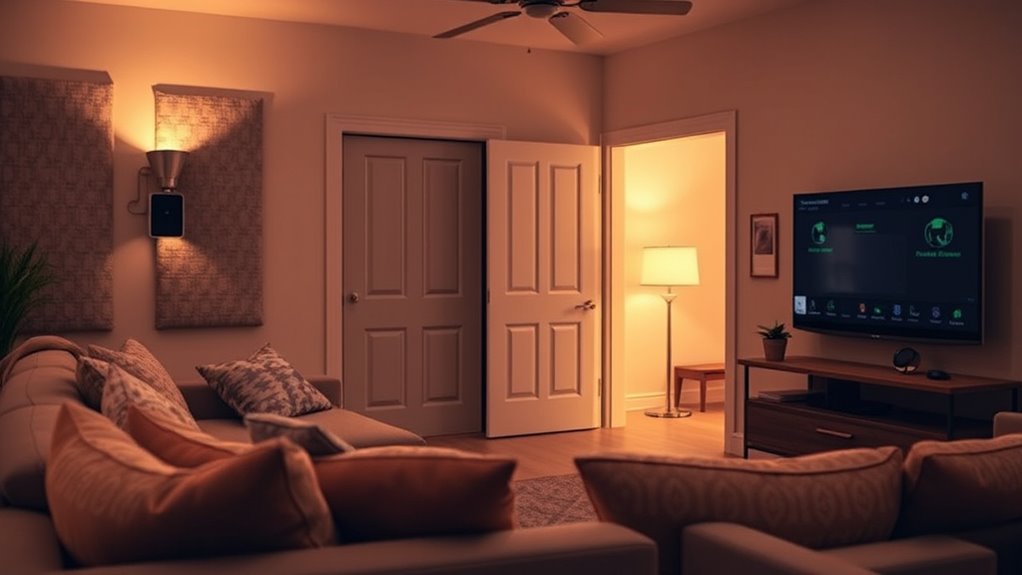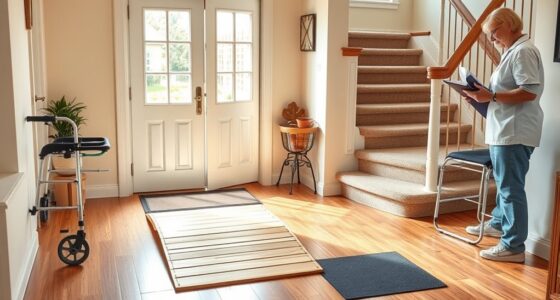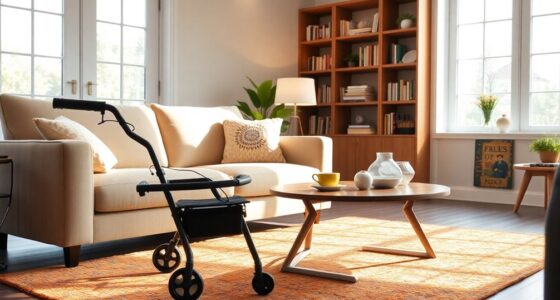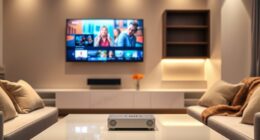To adapt your home for hearing loss, install alert systems like visual signals connected to doorbells, alarms, and phones, so you never miss important sounds. Improve acoustics by adding carpets, curtains, or acoustic panels to reduce echo and background noise. Combining these tools with hearing loop systems or vibration alerts creates a safer, more comfortable environment. Keep exploring to discover how these solutions can be tailored to your daily routines for greater independence.
Key Takeaways
- Install visual alert systems linked to doorbells, alarms, and phones to ensure important sounds are noticed.
- Enhance acoustics with carpets, curtains, and acoustic panels to reduce echo and improve sound clarity.
- Use assistive devices like vibrating alerts and remote notification systems for safety and independence.
- Incorporate soundproofing and strategic furniture placement to minimize background noise and improve communication.
- Combine hearing loop systems with acoustic treatments for a comprehensive, inclusive home environment.
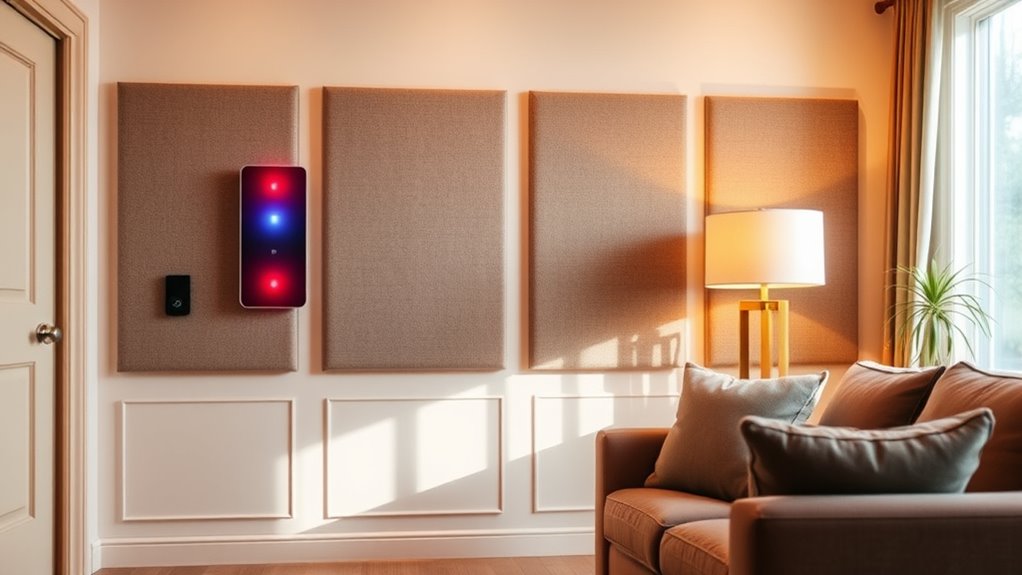
Living with hearing loss can make everyday activities more challenging, but making simple adjustments around your home can markedly improve communication and safety. One effective way to do this is by integrating assistive technology that alerts you to important sounds and events. These devices can include amplified doorbells, vibrating alarm clocks, or remote alert systems that notify you when someone is at the door or if a smoke detector goes off. These tools help you stay aware of your environment without relying solely on hearing, giving you peace of mind and greater independence. Installing visual alerts connected to existing alarm systems or doorbells guarantees you won’t miss critical notifications while going about your day.
Simple home adjustments like visual alerts and assistive devices improve safety and communication for those with hearing loss.
Acoustic treatments are another vital aspect of adapting your home for hearing loss. They involve modifying your space to reduce background noise and improve sound clarity. Simple steps such as adding carpets, curtains, or acoustic panels absorb excess sound, making it easier to focus on conversations or auditory cues. Positioning furniture strategically can also help minimize echo and improve sound distribution. For example, placing your sofa or chairs away from reflective surfaces decreases sound bouncing around the room, creating a more acoustically friendly environment. These treatments don’t require major renovations but can markedly enhance the overall sound quality within your home. Additionally, silent communication methods such as sign language or written notes can support clear interaction when hearing is limited. Incorporating soundproofing techniques can further reduce unwanted noise, creating a calmer environment conducive to better hearing and understanding. Furthermore, understanding the importance of sound localization can help you better identify where sounds are coming from, improving safety and awareness.
Combining assistive technology with acoustic treatments creates an all-encompassing approach to making your home safer and more accessible. For instance, using a hearing loop system connected to your hearing aids can funnel sound directly into your devices, reducing background noise and improving speech clarity. Pairing this with acoustic treatments ensures that the room’s environment supports clear communication, especially during conversations or when listening to the TV. It’s important to contemplate the specific sounds that are most essential for you—whether it’s the doorbell, phone, or a baby crying—and choose alert systems accordingly. Many modern assistive devices can be customized, allowing you to select the alerts that best suit your daily routine.
Ultimately, these adjustments empower you to navigate your home more confidently. They help minimize frustration caused by missed sounds or confusing acoustics and foster a safer, more comfortable space. Adapting your environment with assistive technology and acoustic treatments requires minimal investment but leads to notable improvements in your daily life. By making these changes, you can enjoy better communication, heightened safety, and a more inclusive home that caters to your hearing needs.
Frequently Asked Questions
How Do I Choose the Best Alert System for My Specific Needs?
When choosing the best alert system for your needs, consider wireless options for flexibility and ease of placement. Look for systems with customization features so you can tailor alerts to your environment and preferences. Assess your specific hearing loss level, the types of alerts you need (visual, vibration, or sound), and your budget. Testing different systems helps guarantee you select one that effectively enhances your safety and daily life.
Are There Affordable Options for Home Acoustics Adjustments?
You can find affordable solutions for home acoustics enhancements by exploring simple adjustments like adding soft furnishings, area rugs, and curtains to reduce echo and improve sound clarity. Consider using acoustic panels or foam tiles, which are budget-friendly and easy to install. These acoustic enhancements help make your space more comfortable for hearing, without breaking the bank. Shopping online or at home improvement stores can give you plenty of cost-effective options.
Can I Retrofit Existing Home Features for Better Sound Amplification?
You can definitely retrofit your home for better sound amplification by focusing on key features. Improve your home insulation to reduce noise transfer and upgrade your windows to enhance sound clarity. These simple adjustments make a big difference, helping you enjoy clearer audio throughout your space. By upgrading your insulation and windows, you create a more acoustically friendly environment, making it easier to hear and engage in everyday conversations.
What Safety Considerations Are There for Visual Alert Devices?
When using visual alert devices, focus on fire safety and electrical safety. Make certain devices are properly installed and meet safety standards to prevent electrical hazards. Keep fire alarms connected to your home’s fire safety system and regularly test them. Avoid overloading circuits, and position visual alerts where they’re clearly visible, especially in bedrooms and main living areas. This way, you stay safe while effectively being alerted to emergencies.
How Do I Test if My Home Modifications Are Effective?
To test if your home modifications are effective, try simulating typical alert scenarios, like ringing a doorbell or alarm, and see if your visual alert devices activate promptly. Use soundproofing techniques and noise reduction strategies to minimize background noise, making alerts clearer. Ask a family member to help test various sounds and confirm your hearing loss accommodations work well, providing you peace of mind.
Conclusion
By implementing alert systems and optimizing your home‘s acoustics, you create a safer, more comfortable space for yourself or loved ones with hearing loss. These adaptations make daily life easier and guarantee you stay connected and aware of important sounds. Don’t you want to enjoy a home that truly works for you? Taking small steps now can make a big difference in your independence and peace of mind. Start transforming your home today—your future self will thank you.
